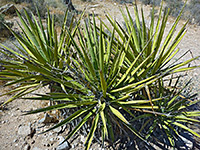Yucca are characterized by dense rosettes of narrow, thin, closely-spaced leaves, often edged by short, white, curling hairs. The leaf tip may have a spine but this is less sharp than on agave plants. There are 27 US species, much more widely distributed than agave, ranging across the Midwest, Great Plains and all the eastern states in addition to the south, in mixed environments including deserts, grassland, mountains and coastal scrub. They also extend through Mexico towards Central America. All species have the capability to grow tall and branch, though in some arid locations this does not happen, and the plants remain compact and single. Flowers are white and bell-shaped, growing in a great mass on a shortish stalk; they are usually produced once a year though may not appear if weather conditions are unfavorable.
Hesperoyucca is a very similar genus, differentiated by characteristics of the inflorescence and the fruits; there are only two species, in non-overlapping regions (hesperoyucca newberryi of northwest Arizona and hesperoyucca whipplei of south California).
Other US yucca species, mostly found in Texas and states further east:
Yucca aloifolia, dagger plant, southeast US coastal states from Texas to North Carolina
Yucca arkansana, Arkansas yucca, east Texas, east Oklahoma and west Arkansas
Yucca campestris, plains yucca, west Texas (southern Panhandle)
Yucca filamentosa, Adam's needles, east USA (Texas to Virginia)
Yucca flaccida, beargrass, southeast USA
Yucca glauca, soapweed yucca, Texas and New Mexico north to Montana and North Dakota
Yucca gloriosa, moundlily yucca, southeast USA
Yucca louisianensis, Gulf Coast yucca, east Texas, south Arkansas and west Louisiana
Yucca necopina, Brazos River yucca, east Texas (rare)
Yucca reverchonii, San Angelo yucca, south central Texas
Yucca rupicola, Texas yucca, east central Texas
Yucca tenuistyla, white rim yucca, east Texas
Hesperoyucca is a very similar genus, differentiated by characteristics of the inflorescence and the fruits; there are only two species, in non-overlapping regions (hesperoyucca newberryi of northwest Arizona and hesperoyucca whipplei of south California).
Other US yucca species, mostly found in Texas and states further east:
Yucca aloifolia, dagger plant, southeast US coastal states from Texas to North Carolina
Yucca arkansana, Arkansas yucca, east Texas, east Oklahoma and west Arkansas
Yucca campestris, plains yucca, west Texas (southern Panhandle)
Yucca filamentosa, Adam's needles, east USA (Texas to Virginia)
Yucca flaccida, beargrass, southeast USA
Yucca glauca, soapweed yucca, Texas and New Mexico north to Montana and North Dakota
Yucca gloriosa, moundlily yucca, southeast USA
Yucca louisianensis, Gulf Coast yucca, east Texas, south Arkansas and west Louisiana
Yucca necopina, Brazos River yucca, east Texas (rare)
Yucca reverchonii, San Angelo yucca, south central Texas
Yucca rupicola, Texas yucca, east central Texas
Yucca tenuistyla, white rim yucca, east Texas
All Contents © Copyright The American Southwest | Comments and Questions | Contribute | Affiliate Marketing Disclosure | Site Map















